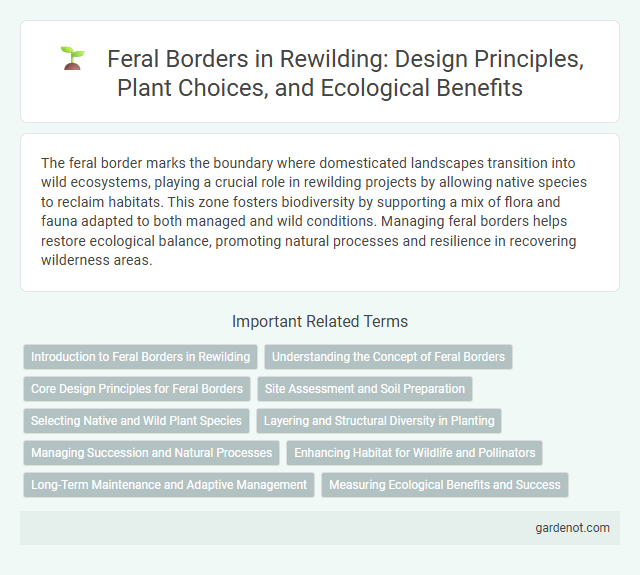The feral border marks the boundary where domesticated landscapes transition into wild ecosystems, playing a crucial role in rewilding projects by allowing native species to reclaim habitats. This zone fosters biodiversity by supporting a mix of flora and fauna adapted to both managed and wild conditions. Managing feral borders helps restore ecological balance, promoting natural processes and resilience in recovering wilderness areas.
Introduction to Feral Borders in Rewilding
Feral borders represent transitional zones where human-managed landscapes meet rewilded ecosystems, serving as essential buffers that support biodiversity and ecological connectivity. These areas facilitate the natural behaviors and movements of wildlife species, helping restore native habitats and ecological processes. Managing feral borders involves balancing species reintroduction efforts with minimal human intervention to promote resilient and self-sustaining ecosystems.
Understanding the Concept of Feral Borders
Feral borders refer to the natural, unmanaged boundaries between rewilded landscapes and human-dominated areas, where ecosystems transition without artificial barriers. These zones foster biodiversity by allowing species to move freely, promoting genetic exchange and ecological resilience. Understanding feral borders is crucial for effective rewilding strategies that balance conservation goals with human land use.
Core Design Principles for Feral Borders
Feral borders prioritize natural regeneration by minimizing human intervention and allowing native species to reestablish without artificial barriers. Core design principles emphasize creating buffer zones that support wildlife corridors, promoting ecological connectivity and enhancing biodiversity. These borders integrate adaptive management techniques to respond to environmental changes, ensuring resilience and long-term ecosystem health.
Site Assessment and Soil Preparation
Feral border site assessment involves evaluating soil quality, native vegetation, and existing wildlife to ensure habitat restoration success. Soil preparation includes removing invasive species, enhancing organic matter, and adjusting pH levels to support native plant regeneration. These steps promote biodiversity, soil health, and ecosystem resilience in rewilding projects.
Selecting Native and Wild Plant Species
Selecting native and wild plant species for the feral border enhances biodiversity by supporting local wildlife and restoring natural ecosystems. Prioritizing species adapted to regional soil and climate conditions promotes resilience and reduces maintenance requirements. Integrating diverse functional groups, such as pollinator-attracting flowers and native grasses, fosters a balanced habitat that sustains indigenous fauna and ecological processes.
Layering and Structural Diversity in Planting
Layering and structural diversity in planting are essential components of feral border design, promoting complex habitats that support diverse wildlife populations. By integrating multiple plant strata--such as ground covers, shrubs, and canopy trees--each layer offers unique resources like shelter, food, and nesting sites. This vertical complexity enhances ecological resilience, fosters niche differentiation, and improves habitat connectivity within rewilded landscapes.
Managing Succession and Natural Processes
Managing succession and natural processes in the feral border enables ecosystems to restore biodiversity and resilience without human interference. Allowing native species to recolonize and controlling invasive plants through minimal intervention supports habitat complexity and ecological balance. Monitoring natural fire regimes and soil dynamics fosters the development of self-sustaining vegetation communities essential for rewilding success.
Enhancing Habitat for Wildlife and Pollinators
Feral borders create vital transitional zones that boost biodiversity by providing diverse habitats for wildlife and pollinators. These unmanaged areas offer abundant native plants, nesting sites, and shelter, supporting species such as bees, butterflies, small mammals, and birds crucial for ecosystem stability. Incorporating feral borders into land management enhances natural regeneration, promotes pollination services, and strengthens ecological connectivity across fragmented landscapes.
Long-Term Maintenance and Adaptive Management
Feral borders require long-term maintenance strategies that prioritize ecological balance through continuous monitoring of native species restoration and invasive species control. Adaptive management involves flexible interventions based on real-time data to ensure habitat resilience and biodiversity enhancement. Effective rewilding depends on integrating scientific research with local stakeholder engagement to sustain feral border ecosystems over time.
Measuring Ecological Benefits and Success
Measuring ecological benefits in feral border rewilding involves assessing biodiversity indices, habitat connectivity, and species population recovery rates to gauge success. Remote sensing technology and field surveys provide critical data on ecosystem functionality and resilience within reclaimed landscapes. Quantifying carbon sequestration and soil health improvements further validates the environmental impact of these rewilded border areas.
Feral border Infographic

 gardenot.com
gardenot.com